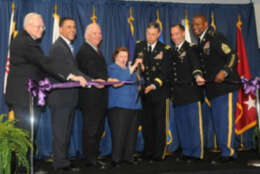Defense Information Systems Agency
-
In the latest installment of BRAC Impact: A Federal News Radio and WTOP In-Depth Series, Jack Penkoske discusses about the telework option to help with the transportation challenges brought on by BRAC.
May 11, 2011 -
For military bases in the national capital region, forget the \"closure\" part of Base Realignment and Closure. The 2005 BRAC round means huge growth at bases around Washington, and along with it, a need for new infrastructure and creature comforts for the growing workforce.
May 10, 2011 -
In a column for Federal News Radio, Ft. Meade Commander Col. Dan Thomas says, \"By this fall, the official worker population of Fort Meade will have grown to more than 48,000. This is 13,000 more personnel than we had three years ago - you do the math: if BRAC growth is 5,400, who are all these other people?\"
May 10, 2011 -
Moving into a new building has allowed DISA to revamp its technology infrastructure, including consolidating circuits, servers and paper records. The Joint Task Force, National Capital Region Medical is building a new network to carry health data and applications for three services to share. Both organizations say without BRAC, these changes would have taken longer to happen.
May 10, 2011 -
Federal News Radio conducted an online survey about how the changes to DoD\'s structure and facilities is affecting federal employees. Respondents expressed frustration over planning, concern over traffic, and doubt about whether moving offices will improve how they meet their mission.
May 09, 2011 -
When Stewart Schwartz, executive director of the Coalition for Smarter Growth, takes a look at the local BRAC sites -- the Mark Center, Fort Belvoir, Quantico Marine Base, Bethesda Naval and Fort Meade -- he sees a \"meltdown.\"
May 09, 2011 -
Federal News Radio has compiled a list of important links and resources on the 2005 Base Realignment and Closure.
May 09, 2011 -
Days after landing a $21 million contract with Agriculture, SAIC has gotten a new contract.
May 06, 2011 -
Just how many Defense Department employees will eventually be using a cloud-based e-mail service depends who you ask. Maj. Gen. Ronnie Hawkins, the Defense Information Systems Agency’s vice director, told reporters Tuesday, selling the Navy and Air Force on its cloud-based email system is a matter of when, not if. However, Hawkins admits, “If you [...]
May 05, 2011 -
The Army is moving its email to the Defense Information Systems Agency\'s cloud. DISA\'s vice chief told reporters Tuesday that getting the rest of the military services on board was a question of when, not if.
May 04, 2011 -
The Defense Department is creating identity and access management tools as an enterprise service across the department. One possible way ahead, leaders say, is a single authoritative digital identity system the Defense Information Systems Agency created to support the Army\'s move to enterprise email.
April 29, 2011 -
The Defense Information Systems Agency celebrated the ceremonial opening of its new 95-acre headquarters campus on Friday. Less than half of the 4,600 employees already work at its new headquarters at Fort Meade, Md. The agency expects the rest of its staff to move there from several northern Virginia locations by late August.
April 18, 2011 -
The Defense Information Systems Agency is asking industry for proposals to cut the tab for satellite communications in Iraq and Afghanistan.
April 15, 2011 -
Reducing traffic at Fort Meade relies on telework.
April 11, 2011 -
The Defense Information Systems Agency awarded one of the remaining big deals under the Networx telecommunications contract to Qwest.
March 30, 2011




